Preventing Medication Errors: Importance of Electronic Prescription Software in Clinical Decision Support
VerifiedAdded on 2023/06/07
|13
|3887
|106
AI Summary
This case study examines the role of electronic prescription software as a clinical decision support tool in preventing medication errors. It also discusses the importance of patient records, appropriate use of hybrid and paper medical records, and the non-detection of errors in the electronic health recording system. Recommendations include improving the effectiveness of the clinical decision support system and individual and family responsibility in healthcare.
Contribute Materials
Your contribution can guide someone’s learning journey. Share your
documents today.
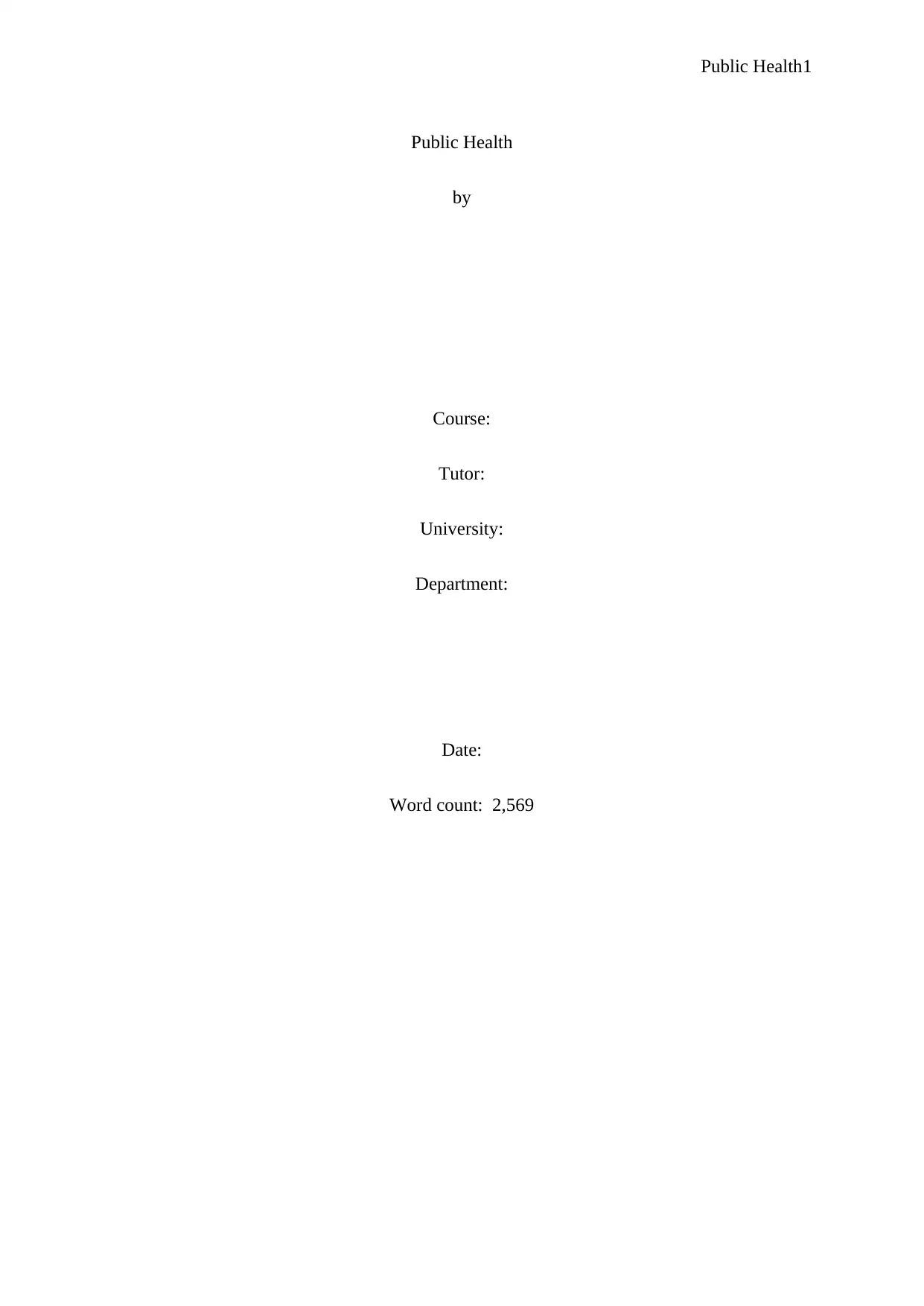
Public Health1
Public Health
by
Course:
Tutor:
University:
Department:
Date:
Word count: 2,569
Public Health
by
Course:
Tutor:
University:
Department:
Date:
Word count: 2,569
Secure Best Marks with AI Grader
Need help grading? Try our AI Grader for instant feedback on your assignments.
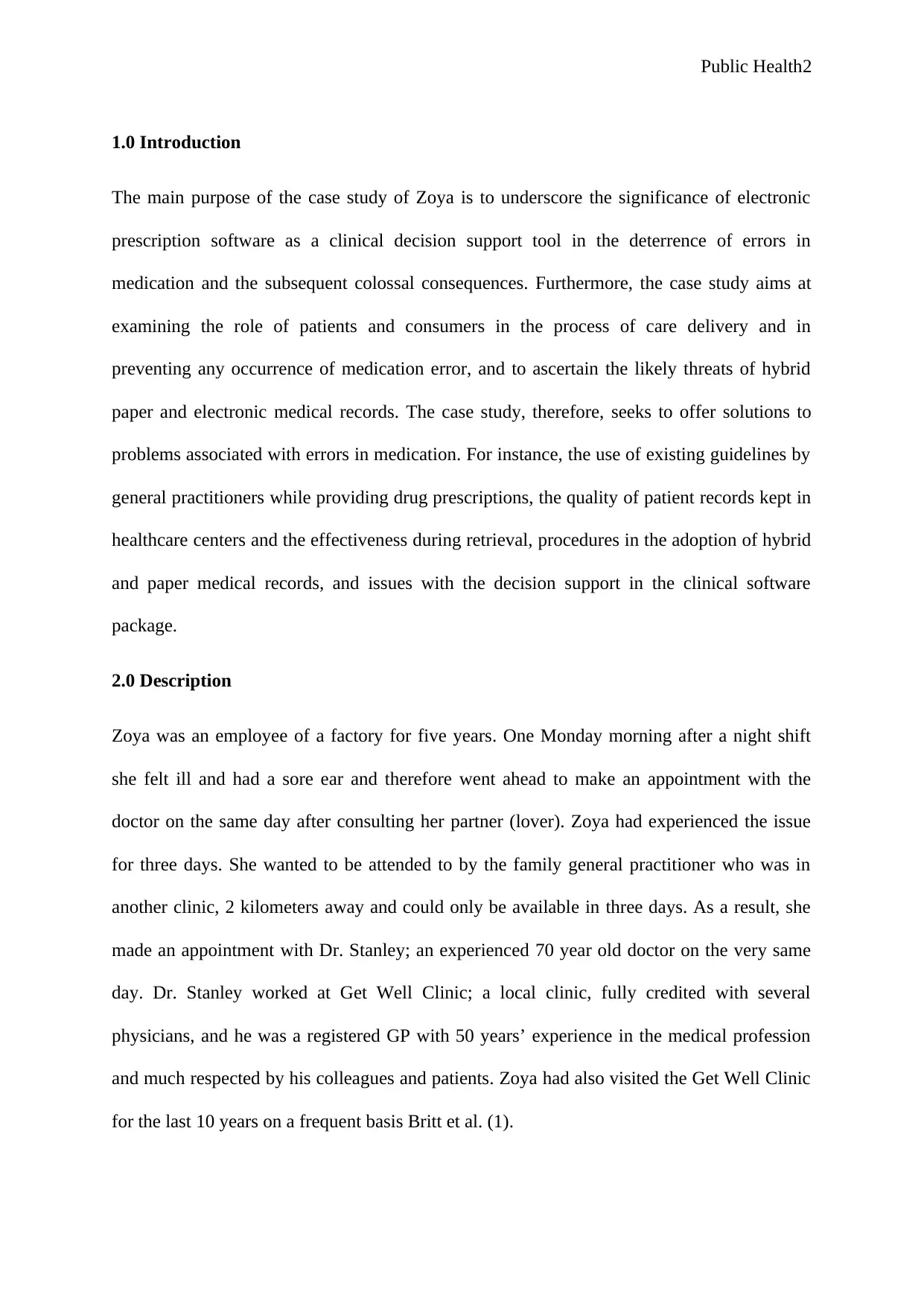
Public Health2
1.0 Introduction
The main purpose of the case study of Zoya is to underscore the significance of electronic
prescription software as a clinical decision support tool in the deterrence of errors in
medication and the subsequent colossal consequences. Furthermore, the case study aims at
examining the role of patients and consumers in the process of care delivery and in
preventing any occurrence of medication error, and to ascertain the likely threats of hybrid
paper and electronic medical records. The case study, therefore, seeks to offer solutions to
problems associated with errors in medication. For instance, the use of existing guidelines by
general practitioners while providing drug prescriptions, the quality of patient records kept in
healthcare centers and the effectiveness during retrieval, procedures in the adoption of hybrid
and paper medical records, and issues with the decision support in the clinical software
package.
2.0 Description
Zoya was an employee of a factory for five years. One Monday morning after a night shift
she felt ill and had a sore ear and therefore went ahead to make an appointment with the
doctor on the same day after consulting her partner (lover). Zoya had experienced the issue
for three days. She wanted to be attended to by the family general practitioner who was in
another clinic, 2 kilometers away and could only be available in three days. As a result, she
made an appointment with Dr. Stanley; an experienced 70 year old doctor on the very same
day. Dr. Stanley worked at Get Well Clinic; a local clinic, fully credited with several
physicians, and he was a registered GP with 50 years’ experience in the medical profession
and much respected by his colleagues and patients. Zoya had also visited the Get Well Clinic
for the last 10 years on a frequent basis Britt et al. (1).
1.0 Introduction
The main purpose of the case study of Zoya is to underscore the significance of electronic
prescription software as a clinical decision support tool in the deterrence of errors in
medication and the subsequent colossal consequences. Furthermore, the case study aims at
examining the role of patients and consumers in the process of care delivery and in
preventing any occurrence of medication error, and to ascertain the likely threats of hybrid
paper and electronic medical records. The case study, therefore, seeks to offer solutions to
problems associated with errors in medication. For instance, the use of existing guidelines by
general practitioners while providing drug prescriptions, the quality of patient records kept in
healthcare centers and the effectiveness during retrieval, procedures in the adoption of hybrid
and paper medical records, and issues with the decision support in the clinical software
package.
2.0 Description
Zoya was an employee of a factory for five years. One Monday morning after a night shift
she felt ill and had a sore ear and therefore went ahead to make an appointment with the
doctor on the same day after consulting her partner (lover). Zoya had experienced the issue
for three days. She wanted to be attended to by the family general practitioner who was in
another clinic, 2 kilometers away and could only be available in three days. As a result, she
made an appointment with Dr. Stanley; an experienced 70 year old doctor on the very same
day. Dr. Stanley worked at Get Well Clinic; a local clinic, fully credited with several
physicians, and he was a registered GP with 50 years’ experience in the medical profession
and much respected by his colleagues and patients. Zoya had also visited the Get Well Clinic
for the last 10 years on a frequent basis Britt et al. (1).
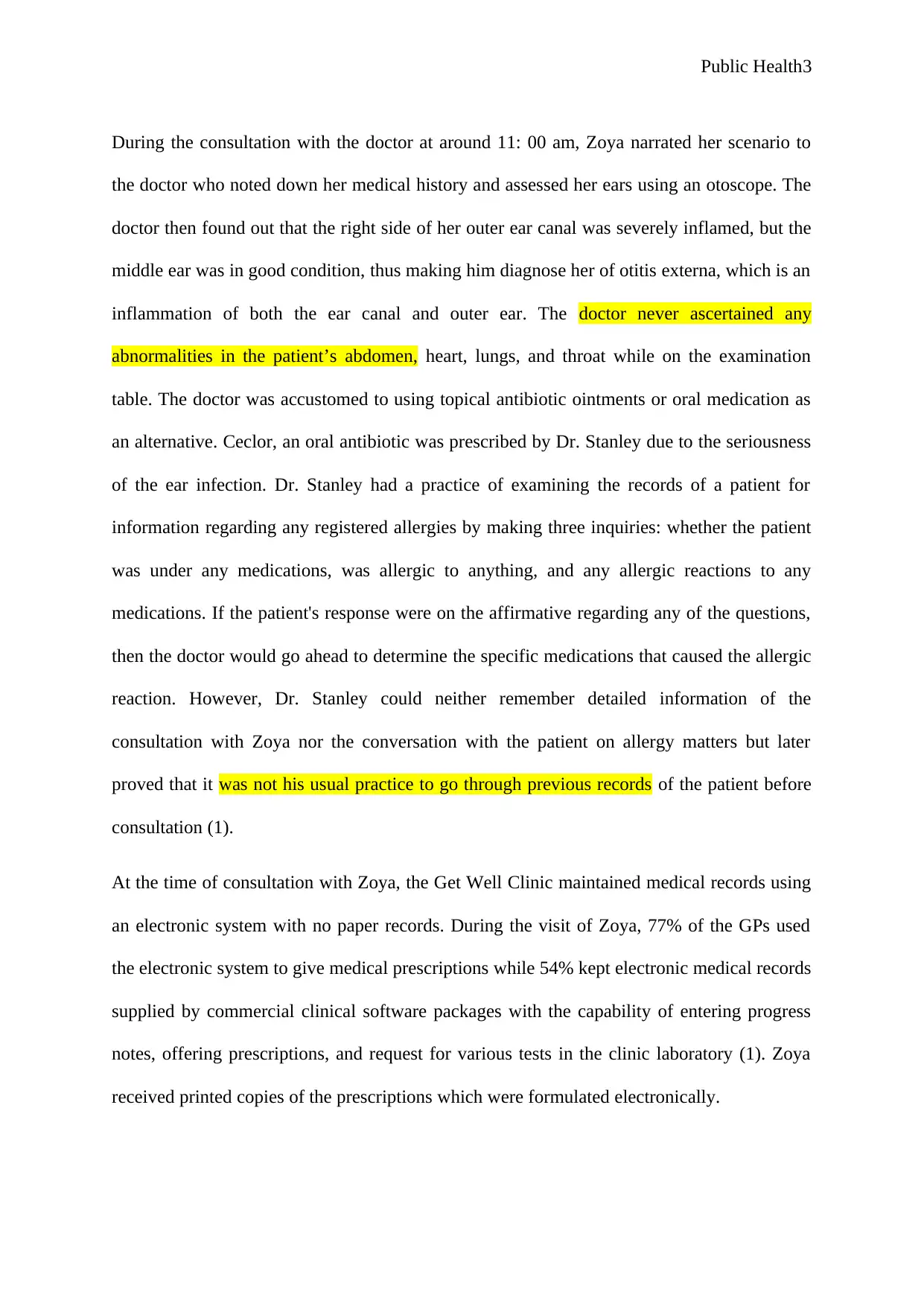
Public Health3
During the consultation with the doctor at around 11: 00 am, Zoya narrated her scenario to
the doctor who noted down her medical history and assessed her ears using an otoscope. The
doctor then found out that the right side of her outer ear canal was severely inflamed, but the
middle ear was in good condition, thus making him diagnose her of otitis externa, which is an
inflammation of both the ear canal and outer ear. The doctor never ascertained any
abnormalities in the patient’s abdomen, heart, lungs, and throat while on the examination
table. The doctor was accustomed to using topical antibiotic ointments or oral medication as
an alternative. Ceclor, an oral antibiotic was prescribed by Dr. Stanley due to the seriousness
of the ear infection. Dr. Stanley had a practice of examining the records of a patient for
information regarding any registered allergies by making three inquiries: whether the patient
was under any medications, was allergic to anything, and any allergic reactions to any
medications. If the patient's response were on the affirmative regarding any of the questions,
then the doctor would go ahead to determine the specific medications that caused the allergic
reaction. However, Dr. Stanley could neither remember detailed information of the
consultation with Zoya nor the conversation with the patient on allergy matters but later
proved that it was not his usual practice to go through previous records of the patient before
consultation (1).
At the time of consultation with Zoya, the Get Well Clinic maintained medical records using
an electronic system with no paper records. During the visit of Zoya, 77% of the GPs used
the electronic system to give medical prescriptions while 54% kept electronic medical records
supplied by commercial clinical software packages with the capability of entering progress
notes, offering prescriptions, and request for various tests in the clinic laboratory (1). Zoya
received printed copies of the prescriptions which were formulated electronically.
During the consultation with the doctor at around 11: 00 am, Zoya narrated her scenario to
the doctor who noted down her medical history and assessed her ears using an otoscope. The
doctor then found out that the right side of her outer ear canal was severely inflamed, but the
middle ear was in good condition, thus making him diagnose her of otitis externa, which is an
inflammation of both the ear canal and outer ear. The doctor never ascertained any
abnormalities in the patient’s abdomen, heart, lungs, and throat while on the examination
table. The doctor was accustomed to using topical antibiotic ointments or oral medication as
an alternative. Ceclor, an oral antibiotic was prescribed by Dr. Stanley due to the seriousness
of the ear infection. Dr. Stanley had a practice of examining the records of a patient for
information regarding any registered allergies by making three inquiries: whether the patient
was under any medications, was allergic to anything, and any allergic reactions to any
medications. If the patient's response were on the affirmative regarding any of the questions,
then the doctor would go ahead to determine the specific medications that caused the allergic
reaction. However, Dr. Stanley could neither remember detailed information of the
consultation with Zoya nor the conversation with the patient on allergy matters but later
proved that it was not his usual practice to go through previous records of the patient before
consultation (1).
At the time of consultation with Zoya, the Get Well Clinic maintained medical records using
an electronic system with no paper records. During the visit of Zoya, 77% of the GPs used
the electronic system to give medical prescriptions while 54% kept electronic medical records
supplied by commercial clinical software packages with the capability of entering progress
notes, offering prescriptions, and request for various tests in the clinic laboratory (1). Zoya
received printed copies of the prescriptions which were formulated electronically.
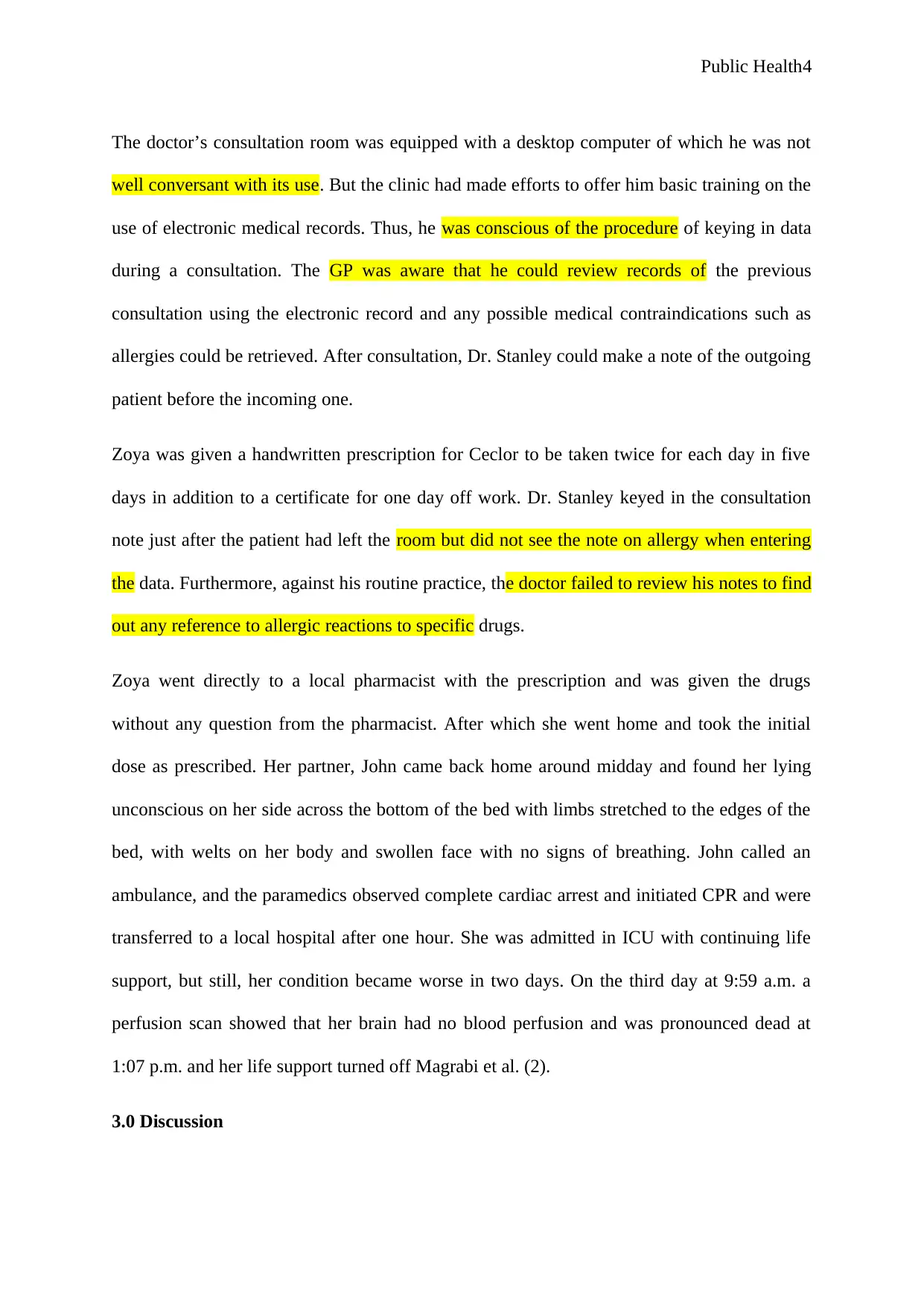
Public Health4
The doctor’s consultation room was equipped with a desktop computer of which he was not
well conversant with its use. But the clinic had made efforts to offer him basic training on the
use of electronic medical records. Thus, he was conscious of the procedure of keying in data
during a consultation. The GP was aware that he could review records of the previous
consultation using the electronic record and any possible medical contraindications such as
allergies could be retrieved. After consultation, Dr. Stanley could make a note of the outgoing
patient before the incoming one.
Zoya was given a handwritten prescription for Ceclor to be taken twice for each day in five
days in addition to a certificate for one day off work. Dr. Stanley keyed in the consultation
note just after the patient had left the room but did not see the note on allergy when entering
the data. Furthermore, against his routine practice, the doctor failed to review his notes to find
out any reference to allergic reactions to specific drugs.
Zoya went directly to a local pharmacist with the prescription and was given the drugs
without any question from the pharmacist. After which she went home and took the initial
dose as prescribed. Her partner, John came back home around midday and found her lying
unconscious on her side across the bottom of the bed with limbs stretched to the edges of the
bed, with welts on her body and swollen face with no signs of breathing. John called an
ambulance, and the paramedics observed complete cardiac arrest and initiated CPR and were
transferred to a local hospital after one hour. She was admitted in ICU with continuing life
support, but still, her condition became worse in two days. On the third day at 9:59 a.m. a
perfusion scan showed that her brain had no blood perfusion and was pronounced dead at
1:07 p.m. and her life support turned off Magrabi et al. (2).
3.0 Discussion
The doctor’s consultation room was equipped with a desktop computer of which he was not
well conversant with its use. But the clinic had made efforts to offer him basic training on the
use of electronic medical records. Thus, he was conscious of the procedure of keying in data
during a consultation. The GP was aware that he could review records of the previous
consultation using the electronic record and any possible medical contraindications such as
allergies could be retrieved. After consultation, Dr. Stanley could make a note of the outgoing
patient before the incoming one.
Zoya was given a handwritten prescription for Ceclor to be taken twice for each day in five
days in addition to a certificate for one day off work. Dr. Stanley keyed in the consultation
note just after the patient had left the room but did not see the note on allergy when entering
the data. Furthermore, against his routine practice, the doctor failed to review his notes to find
out any reference to allergic reactions to specific drugs.
Zoya went directly to a local pharmacist with the prescription and was given the drugs
without any question from the pharmacist. After which she went home and took the initial
dose as prescribed. Her partner, John came back home around midday and found her lying
unconscious on her side across the bottom of the bed with limbs stretched to the edges of the
bed, with welts on her body and swollen face with no signs of breathing. John called an
ambulance, and the paramedics observed complete cardiac arrest and initiated CPR and were
transferred to a local hospital after one hour. She was admitted in ICU with continuing life
support, but still, her condition became worse in two days. On the third day at 9:59 a.m. a
perfusion scan showed that her brain had no blood perfusion and was pronounced dead at
1:07 p.m. and her life support turned off Magrabi et al. (2).
3.0 Discussion
Secure Best Marks with AI Grader
Need help grading? Try our AI Grader for instant feedback on your assignments.
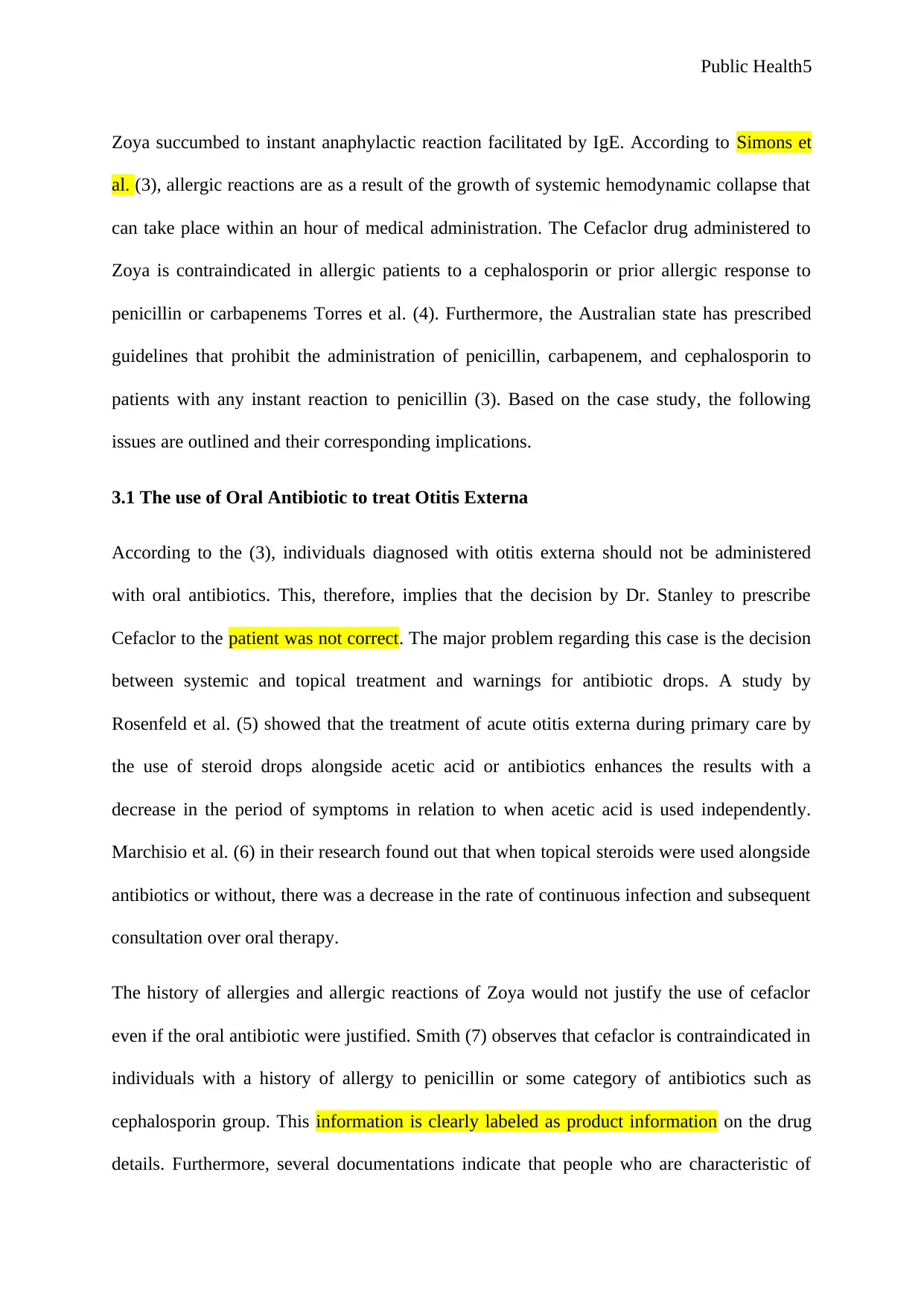
Public Health5
Zoya succumbed to instant anaphylactic reaction facilitated by IgE. According to Simons et
al. (3), allergic reactions are as a result of the growth of systemic hemodynamic collapse that
can take place within an hour of medical administration. The Cefaclor drug administered to
Zoya is contraindicated in allergic patients to a cephalosporin or prior allergic response to
penicillin or carbapenems Torres et al. (4). Furthermore, the Australian state has prescribed
guidelines that prohibit the administration of penicillin, carbapenem, and cephalosporin to
patients with any instant reaction to penicillin (3). Based on the case study, the following
issues are outlined and their corresponding implications.
3.1 The use of Oral Antibiotic to treat Otitis Externa
According to the (3), individuals diagnosed with otitis externa should not be administered
with oral antibiotics. This, therefore, implies that the decision by Dr. Stanley to prescribe
Cefaclor to the patient was not correct. The major problem regarding this case is the decision
between systemic and topical treatment and warnings for antibiotic drops. A study by
Rosenfeld et al. (5) showed that the treatment of acute otitis externa during primary care by
the use of steroid drops alongside acetic acid or antibiotics enhances the results with a
decrease in the period of symptoms in relation to when acetic acid is used independently.
Marchisio et al. (6) in their research found out that when topical steroids were used alongside
antibiotics or without, there was a decrease in the rate of continuous infection and subsequent
consultation over oral therapy.
The history of allergies and allergic reactions of Zoya would not justify the use of cefaclor
even if the oral antibiotic were justified. Smith (7) observes that cefaclor is contraindicated in
individuals with a history of allergy to penicillin or some category of antibiotics such as
cephalosporin group. This information is clearly labeled as product information on the drug
details. Furthermore, several documentations indicate that people who are characteristic of
Zoya succumbed to instant anaphylactic reaction facilitated by IgE. According to Simons et
al. (3), allergic reactions are as a result of the growth of systemic hemodynamic collapse that
can take place within an hour of medical administration. The Cefaclor drug administered to
Zoya is contraindicated in allergic patients to a cephalosporin or prior allergic response to
penicillin or carbapenems Torres et al. (4). Furthermore, the Australian state has prescribed
guidelines that prohibit the administration of penicillin, carbapenem, and cephalosporin to
patients with any instant reaction to penicillin (3). Based on the case study, the following
issues are outlined and their corresponding implications.
3.1 The use of Oral Antibiotic to treat Otitis Externa
According to the (3), individuals diagnosed with otitis externa should not be administered
with oral antibiotics. This, therefore, implies that the decision by Dr. Stanley to prescribe
Cefaclor to the patient was not correct. The major problem regarding this case is the decision
between systemic and topical treatment and warnings for antibiotic drops. A study by
Rosenfeld et al. (5) showed that the treatment of acute otitis externa during primary care by
the use of steroid drops alongside acetic acid or antibiotics enhances the results with a
decrease in the period of symptoms in relation to when acetic acid is used independently.
Marchisio et al. (6) in their research found out that when topical steroids were used alongside
antibiotics or without, there was a decrease in the rate of continuous infection and subsequent
consultation over oral therapy.
The history of allergies and allergic reactions of Zoya would not justify the use of cefaclor
even if the oral antibiotic were justified. Smith (7) observes that cefaclor is contraindicated in
individuals with a history of allergy to penicillin or some category of antibiotics such as
cephalosporin group. This information is clearly labeled as product information on the drug
details. Furthermore, several documentations indicate that people who are characteristic of
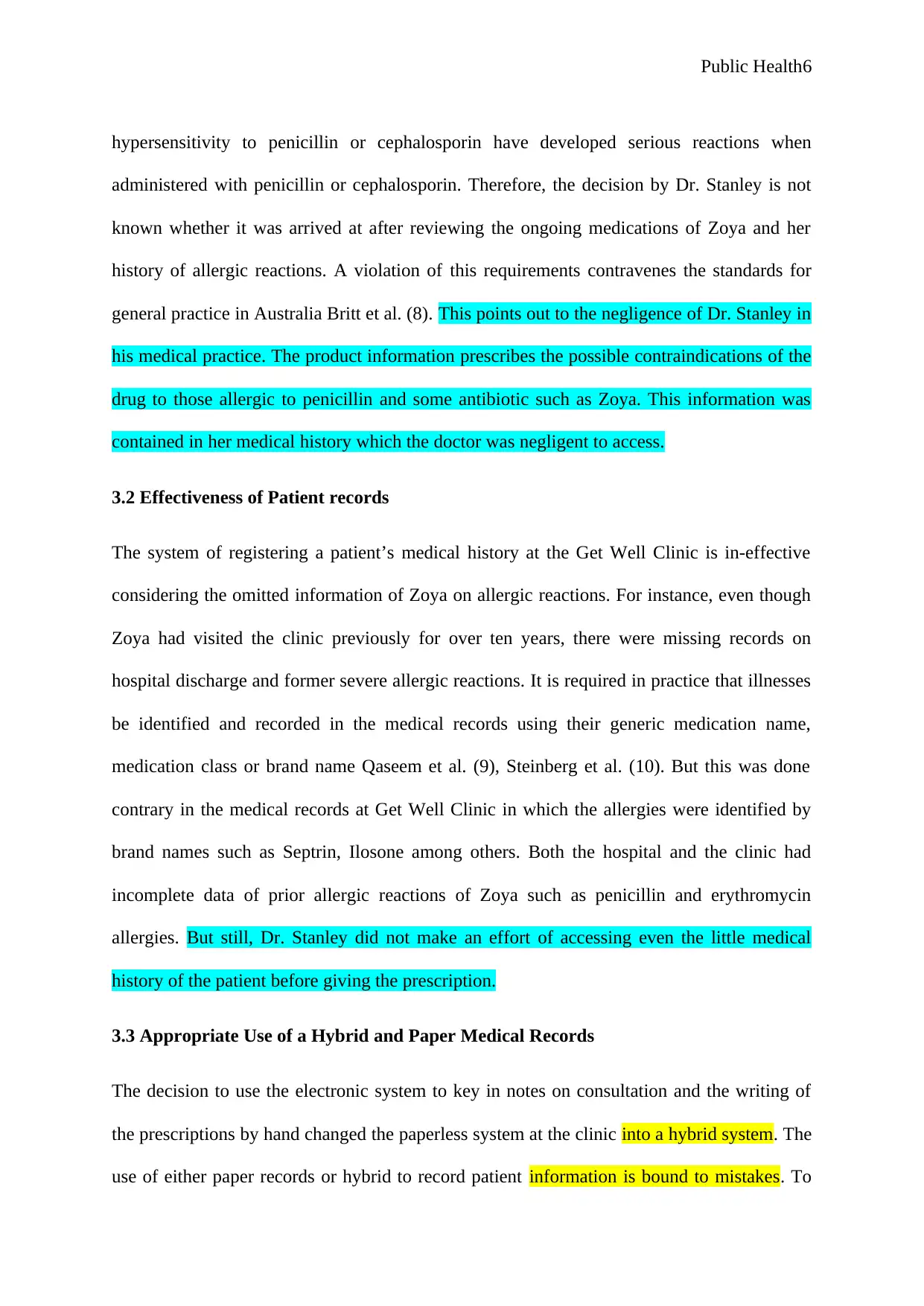
Public Health6
hypersensitivity to penicillin or cephalosporin have developed serious reactions when
administered with penicillin or cephalosporin. Therefore, the decision by Dr. Stanley is not
known whether it was arrived at after reviewing the ongoing medications of Zoya and her
history of allergic reactions. A violation of this requirements contravenes the standards for
general practice in Australia Britt et al. (8). This points out to the negligence of Dr. Stanley in
his medical practice. The product information prescribes the possible contraindications of the
drug to those allergic to penicillin and some antibiotic such as Zoya. This information was
contained in her medical history which the doctor was negligent to access.
3.2 Effectiveness of Patient records
The system of registering a patient’s medical history at the Get Well Clinic is in-effective
considering the omitted information of Zoya on allergic reactions. For instance, even though
Zoya had visited the clinic previously for over ten years, there were missing records on
hospital discharge and former severe allergic reactions. It is required in practice that illnesses
be identified and recorded in the medical records using their generic medication name,
medication class or brand name Qaseem et al. (9), Steinberg et al. (10). But this was done
contrary in the medical records at Get Well Clinic in which the allergies were identified by
brand names such as Septrin, Ilosone among others. Both the hospital and the clinic had
incomplete data of prior allergic reactions of Zoya such as penicillin and erythromycin
allergies. But still, Dr. Stanley did not make an effort of accessing even the little medical
history of the patient before giving the prescription.
3.3 Appropriate Use of a Hybrid and Paper Medical Records
The decision to use the electronic system to key in notes on consultation and the writing of
the prescriptions by hand changed the paperless system at the clinic into a hybrid system. The
use of either paper records or hybrid to record patient information is bound to mistakes. To
hypersensitivity to penicillin or cephalosporin have developed serious reactions when
administered with penicillin or cephalosporin. Therefore, the decision by Dr. Stanley is not
known whether it was arrived at after reviewing the ongoing medications of Zoya and her
history of allergic reactions. A violation of this requirements contravenes the standards for
general practice in Australia Britt et al. (8). This points out to the negligence of Dr. Stanley in
his medical practice. The product information prescribes the possible contraindications of the
drug to those allergic to penicillin and some antibiotic such as Zoya. This information was
contained in her medical history which the doctor was negligent to access.
3.2 Effectiveness of Patient records
The system of registering a patient’s medical history at the Get Well Clinic is in-effective
considering the omitted information of Zoya on allergic reactions. For instance, even though
Zoya had visited the clinic previously for over ten years, there were missing records on
hospital discharge and former severe allergic reactions. It is required in practice that illnesses
be identified and recorded in the medical records using their generic medication name,
medication class or brand name Qaseem et al. (9), Steinberg et al. (10). But this was done
contrary in the medical records at Get Well Clinic in which the allergies were identified by
brand names such as Septrin, Ilosone among others. Both the hospital and the clinic had
incomplete data of prior allergic reactions of Zoya such as penicillin and erythromycin
allergies. But still, Dr. Stanley did not make an effort of accessing even the little medical
history of the patient before giving the prescription.
3.3 Appropriate Use of a Hybrid and Paper Medical Records
The decision to use the electronic system to key in notes on consultation and the writing of
the prescriptions by hand changed the paperless system at the clinic into a hybrid system. The
use of either paper records or hybrid to record patient information is bound to mistakes. To
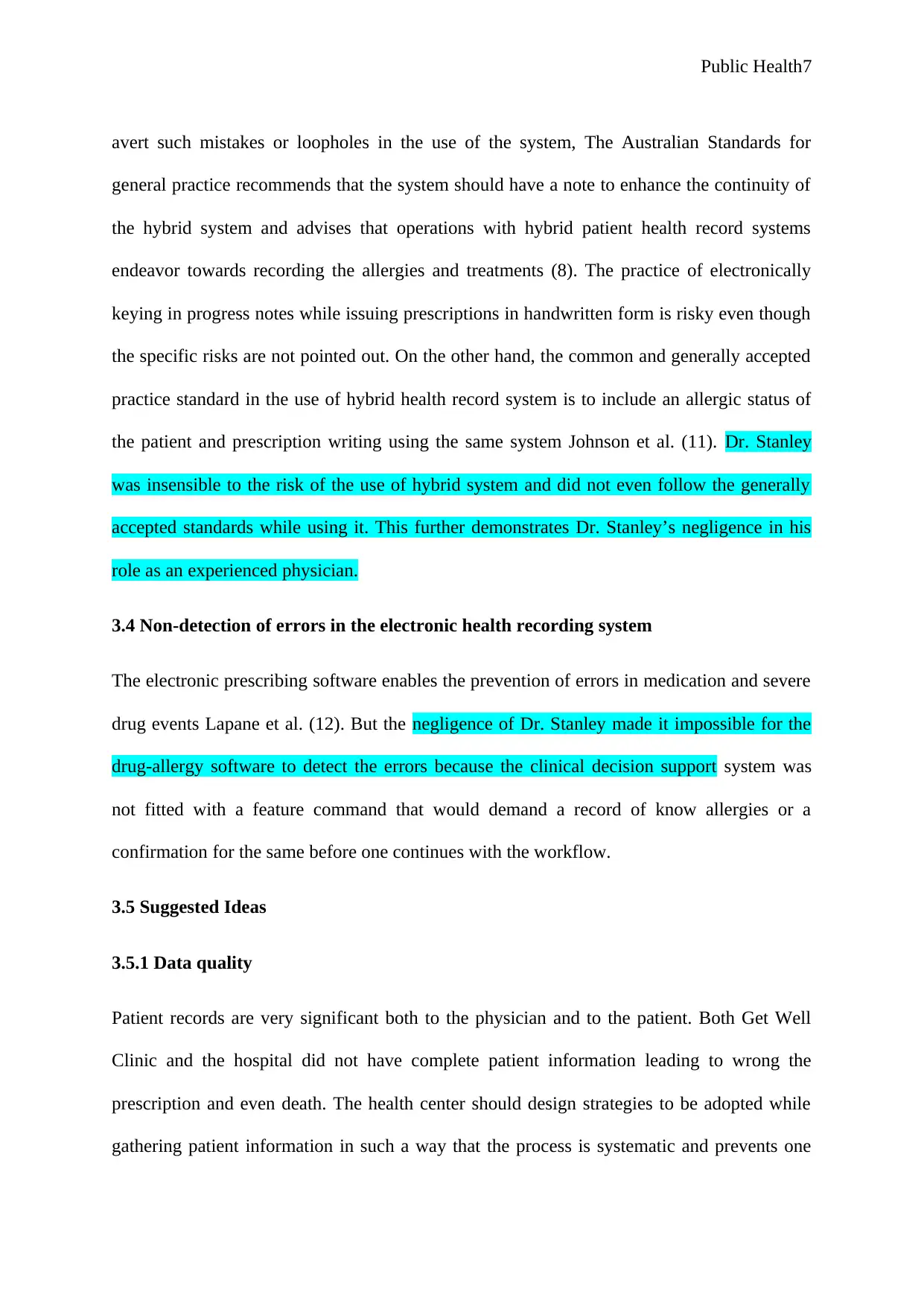
Public Health7
avert such mistakes or loopholes in the use of the system, The Australian Standards for
general practice recommends that the system should have a note to enhance the continuity of
the hybrid system and advises that operations with hybrid patient health record systems
endeavor towards recording the allergies and treatments (8). The practice of electronically
keying in progress notes while issuing prescriptions in handwritten form is risky even though
the specific risks are not pointed out. On the other hand, the common and generally accepted
practice standard in the use of hybrid health record system is to include an allergic status of
the patient and prescription writing using the same system Johnson et al. (11). Dr. Stanley
was insensible to the risk of the use of hybrid system and did not even follow the generally
accepted standards while using it. This further demonstrates Dr. Stanley’s negligence in his
role as an experienced physician.
3.4 Non-detection of errors in the electronic health recording system
The electronic prescribing software enables the prevention of errors in medication and severe
drug events Lapane et al. (12). But the negligence of Dr. Stanley made it impossible for the
drug-allergy software to detect the errors because the clinical decision support system was
not fitted with a feature command that would demand a record of know allergies or a
confirmation for the same before one continues with the workflow.
3.5 Suggested Ideas
3.5.1 Data quality
Patient records are very significant both to the physician and to the patient. Both Get Well
Clinic and the hospital did not have complete patient information leading to wrong the
prescription and even death. The health center should design strategies to be adopted while
gathering patient information in such a way that the process is systematic and prevents one
avert such mistakes or loopholes in the use of the system, The Australian Standards for
general practice recommends that the system should have a note to enhance the continuity of
the hybrid system and advises that operations with hybrid patient health record systems
endeavor towards recording the allergies and treatments (8). The practice of electronically
keying in progress notes while issuing prescriptions in handwritten form is risky even though
the specific risks are not pointed out. On the other hand, the common and generally accepted
practice standard in the use of hybrid health record system is to include an allergic status of
the patient and prescription writing using the same system Johnson et al. (11). Dr. Stanley
was insensible to the risk of the use of hybrid system and did not even follow the generally
accepted standards while using it. This further demonstrates Dr. Stanley’s negligence in his
role as an experienced physician.
3.4 Non-detection of errors in the electronic health recording system
The electronic prescribing software enables the prevention of errors in medication and severe
drug events Lapane et al. (12). But the negligence of Dr. Stanley made it impossible for the
drug-allergy software to detect the errors because the clinical decision support system was
not fitted with a feature command that would demand a record of know allergies or a
confirmation for the same before one continues with the workflow.
3.5 Suggested Ideas
3.5.1 Data quality
Patient records are very significant both to the physician and to the patient. Both Get Well
Clinic and the hospital did not have complete patient information leading to wrong the
prescription and even death. The health center should design strategies to be adopted while
gathering patient information in such a way that the process is systematic and prevents one
Paraphrase This Document
Need a fresh take? Get an instant paraphrase of this document with our AI Paraphraser
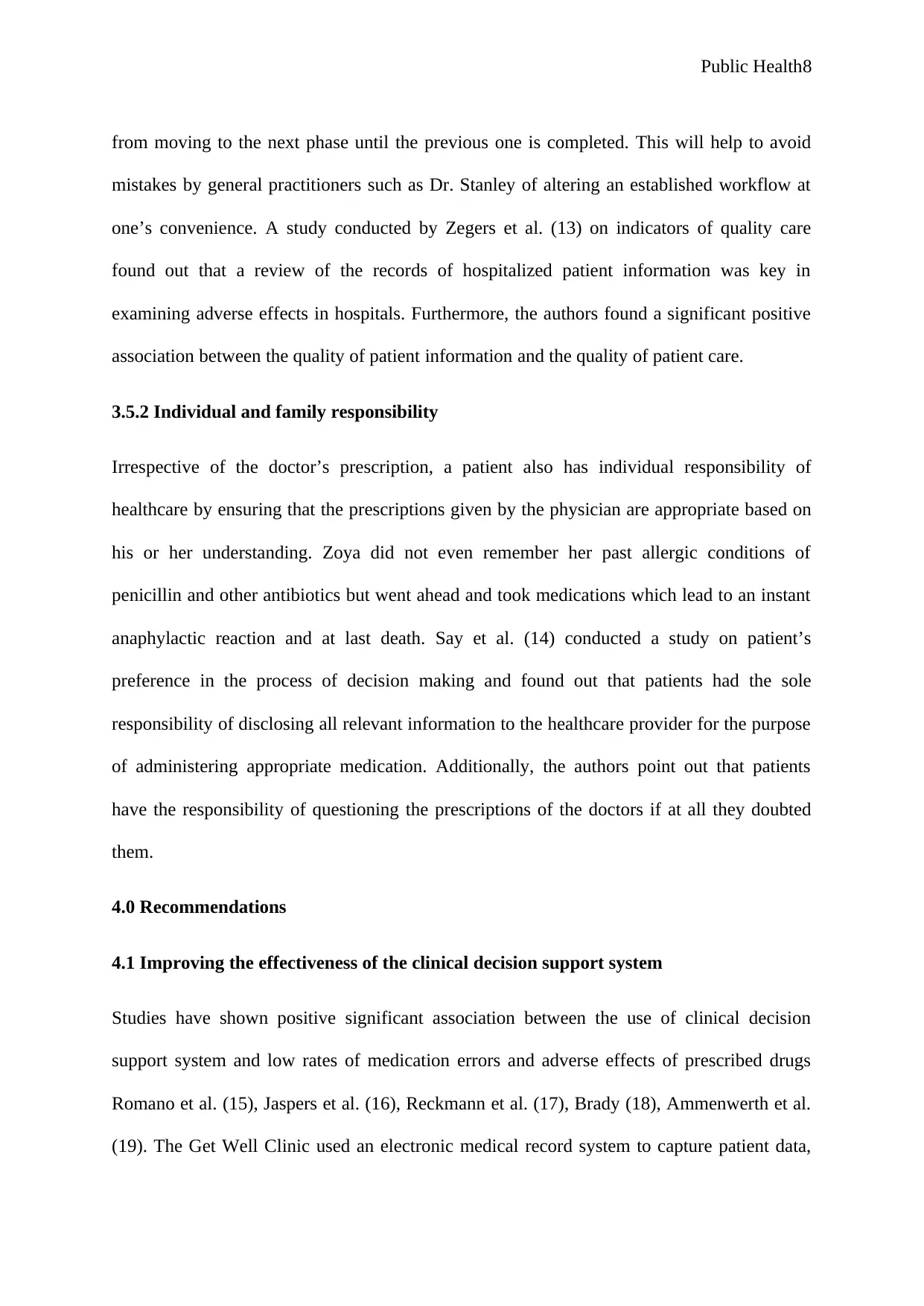
Public Health8
from moving to the next phase until the previous one is completed. This will help to avoid
mistakes by general practitioners such as Dr. Stanley of altering an established workflow at
one’s convenience. A study conducted by Zegers et al. (13) on indicators of quality care
found out that a review of the records of hospitalized patient information was key in
examining adverse effects in hospitals. Furthermore, the authors found a significant positive
association between the quality of patient information and the quality of patient care.
3.5.2 Individual and family responsibility
Irrespective of the doctor’s prescription, a patient also has individual responsibility of
healthcare by ensuring that the prescriptions given by the physician are appropriate based on
his or her understanding. Zoya did not even remember her past allergic conditions of
penicillin and other antibiotics but went ahead and took medications which lead to an instant
anaphylactic reaction and at last death. Say et al. (14) conducted a study on patient’s
preference in the process of decision making and found out that patients had the sole
responsibility of disclosing all relevant information to the healthcare provider for the purpose
of administering appropriate medication. Additionally, the authors point out that patients
have the responsibility of questioning the prescriptions of the doctors if at all they doubted
them.
4.0 Recommendations
4.1 Improving the effectiveness of the clinical decision support system
Studies have shown positive significant association between the use of clinical decision
support system and low rates of medication errors and adverse effects of prescribed drugs
Romano et al. (15), Jaspers et al. (16), Reckmann et al. (17), Brady (18), Ammenwerth et al.
(19). The Get Well Clinic used an electronic medical record system to capture patient data,
from moving to the next phase until the previous one is completed. This will help to avoid
mistakes by general practitioners such as Dr. Stanley of altering an established workflow at
one’s convenience. A study conducted by Zegers et al. (13) on indicators of quality care
found out that a review of the records of hospitalized patient information was key in
examining adverse effects in hospitals. Furthermore, the authors found a significant positive
association between the quality of patient information and the quality of patient care.
3.5.2 Individual and family responsibility
Irrespective of the doctor’s prescription, a patient also has individual responsibility of
healthcare by ensuring that the prescriptions given by the physician are appropriate based on
his or her understanding. Zoya did not even remember her past allergic conditions of
penicillin and other antibiotics but went ahead and took medications which lead to an instant
anaphylactic reaction and at last death. Say et al. (14) conducted a study on patient’s
preference in the process of decision making and found out that patients had the sole
responsibility of disclosing all relevant information to the healthcare provider for the purpose
of administering appropriate medication. Additionally, the authors point out that patients
have the responsibility of questioning the prescriptions of the doctors if at all they doubted
them.
4.0 Recommendations
4.1 Improving the effectiveness of the clinical decision support system
Studies have shown positive significant association between the use of clinical decision
support system and low rates of medication errors and adverse effects of prescribed drugs
Romano et al. (15), Jaspers et al. (16), Reckmann et al. (17), Brady (18), Ammenwerth et al.
(19). The Get Well Clinic used an electronic medical record system to capture patient data,
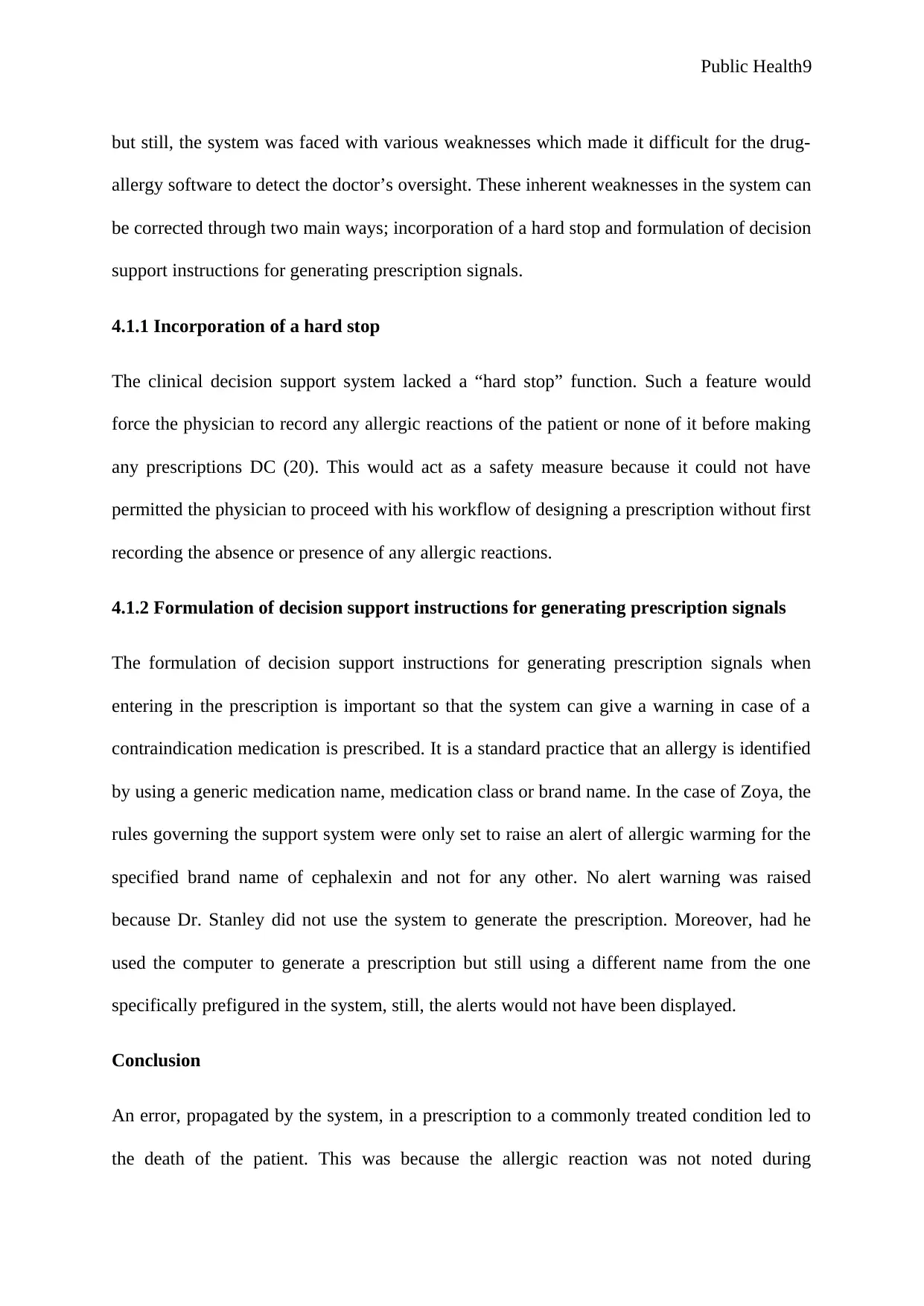
Public Health9
but still, the system was faced with various weaknesses which made it difficult for the drug-
allergy software to detect the doctor’s oversight. These inherent weaknesses in the system can
be corrected through two main ways; incorporation of a hard stop and formulation of decision
support instructions for generating prescription signals.
4.1.1 Incorporation of a hard stop
The clinical decision support system lacked a “hard stop” function. Such a feature would
force the physician to record any allergic reactions of the patient or none of it before making
any prescriptions DC (20). This would act as a safety measure because it could not have
permitted the physician to proceed with his workflow of designing a prescription without first
recording the absence or presence of any allergic reactions.
4.1.2 Formulation of decision support instructions for generating prescription signals
The formulation of decision support instructions for generating prescription signals when
entering in the prescription is important so that the system can give a warning in case of a
contraindication medication is prescribed. It is a standard practice that an allergy is identified
by using a generic medication name, medication class or brand name. In the case of Zoya, the
rules governing the support system were only set to raise an alert of allergic warming for the
specified brand name of cephalexin and not for any other. No alert warning was raised
because Dr. Stanley did not use the system to generate the prescription. Moreover, had he
used the computer to generate a prescription but still using a different name from the one
specifically prefigured in the system, still, the alerts would not have been displayed.
Conclusion
An error, propagated by the system, in a prescription to a commonly treated condition led to
the death of the patient. This was because the allergic reaction was not noted during
but still, the system was faced with various weaknesses which made it difficult for the drug-
allergy software to detect the doctor’s oversight. These inherent weaknesses in the system can
be corrected through two main ways; incorporation of a hard stop and formulation of decision
support instructions for generating prescription signals.
4.1.1 Incorporation of a hard stop
The clinical decision support system lacked a “hard stop” function. Such a feature would
force the physician to record any allergic reactions of the patient or none of it before making
any prescriptions DC (20). This would act as a safety measure because it could not have
permitted the physician to proceed with his workflow of designing a prescription without first
recording the absence or presence of any allergic reactions.
4.1.2 Formulation of decision support instructions for generating prescription signals
The formulation of decision support instructions for generating prescription signals when
entering in the prescription is important so that the system can give a warning in case of a
contraindication medication is prescribed. It is a standard practice that an allergy is identified
by using a generic medication name, medication class or brand name. In the case of Zoya, the
rules governing the support system were only set to raise an alert of allergic warming for the
specified brand name of cephalexin and not for any other. No alert warning was raised
because Dr. Stanley did not use the system to generate the prescription. Moreover, had he
used the computer to generate a prescription but still using a different name from the one
specifically prefigured in the system, still, the alerts would not have been displayed.
Conclusion
An error, propagated by the system, in a prescription to a commonly treated condition led to
the death of the patient. This was because the allergic reaction was not noted during
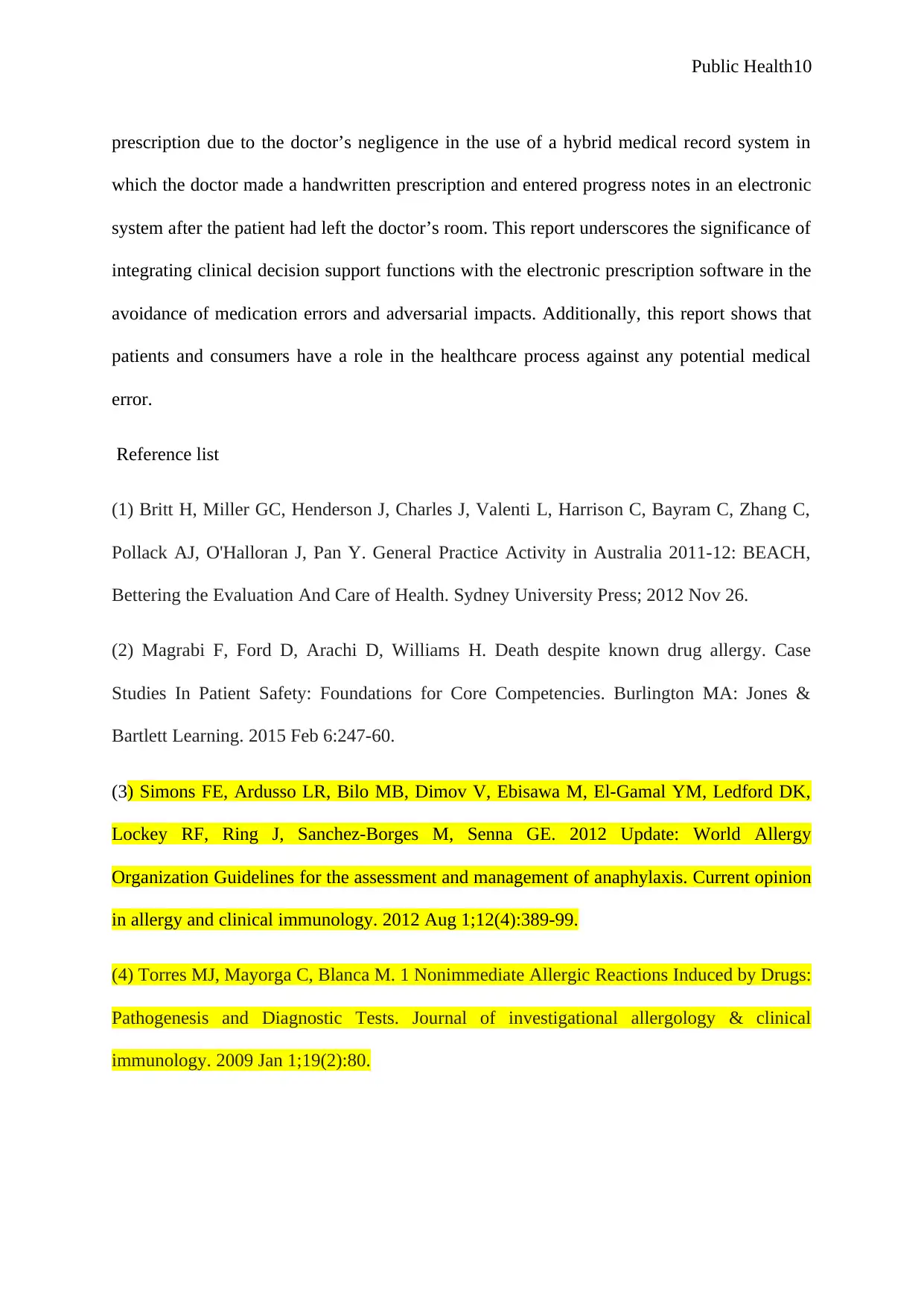
Public Health10
prescription due to the doctor’s negligence in the use of a hybrid medical record system in
which the doctor made a handwritten prescription and entered progress notes in an electronic
system after the patient had left the doctor’s room. This report underscores the significance of
integrating clinical decision support functions with the electronic prescription software in the
avoidance of medication errors and adversarial impacts. Additionally, this report shows that
patients and consumers have a role in the healthcare process against any potential medical
error.
Reference list
(1) Britt H, Miller GC, Henderson J, Charles J, Valenti L, Harrison C, Bayram C, Zhang C,
Pollack AJ, O'Halloran J, Pan Y. General Practice Activity in Australia 2011-12: BEACH,
Bettering the Evaluation And Care of Health. Sydney University Press; 2012 Nov 26.
(2) Magrabi F, Ford D, Arachi D, Williams H. Death despite known drug allergy. Case
Studies In Patient Safety: Foundations for Core Competencies. Burlington MA: Jones &
Bartlett Learning. 2015 Feb 6:247-60.
(3) Simons FE, Ardusso LR, Bilo MB, Dimov V, Ebisawa M, El-Gamal YM, Ledford DK,
Lockey RF, Ring J, Sanchez-Borges M, Senna GE. 2012 Update: World Allergy
Organization Guidelines for the assessment and management of anaphylaxis. Current opinion
in allergy and clinical immunology. 2012 Aug 1;12(4):389-99.
(4) Torres MJ, Mayorga C, Blanca M. 1 Nonimmediate Allergic Reactions Induced by Drugs:
Pathogenesis and Diagnostic Tests. Journal of investigational allergology & clinical
immunology. 2009 Jan 1;19(2):80.
prescription due to the doctor’s negligence in the use of a hybrid medical record system in
which the doctor made a handwritten prescription and entered progress notes in an electronic
system after the patient had left the doctor’s room. This report underscores the significance of
integrating clinical decision support functions with the electronic prescription software in the
avoidance of medication errors and adversarial impacts. Additionally, this report shows that
patients and consumers have a role in the healthcare process against any potential medical
error.
Reference list
(1) Britt H, Miller GC, Henderson J, Charles J, Valenti L, Harrison C, Bayram C, Zhang C,
Pollack AJ, O'Halloran J, Pan Y. General Practice Activity in Australia 2011-12: BEACH,
Bettering the Evaluation And Care of Health. Sydney University Press; 2012 Nov 26.
(2) Magrabi F, Ford D, Arachi D, Williams H. Death despite known drug allergy. Case
Studies In Patient Safety: Foundations for Core Competencies. Burlington MA: Jones &
Bartlett Learning. 2015 Feb 6:247-60.
(3) Simons FE, Ardusso LR, Bilo MB, Dimov V, Ebisawa M, El-Gamal YM, Ledford DK,
Lockey RF, Ring J, Sanchez-Borges M, Senna GE. 2012 Update: World Allergy
Organization Guidelines for the assessment and management of anaphylaxis. Current opinion
in allergy and clinical immunology. 2012 Aug 1;12(4):389-99.
(4) Torres MJ, Mayorga C, Blanca M. 1 Nonimmediate Allergic Reactions Induced by Drugs:
Pathogenesis and Diagnostic Tests. Journal of investigational allergology & clinical
immunology. 2009 Jan 1;19(2):80.
Secure Best Marks with AI Grader
Need help grading? Try our AI Grader for instant feedback on your assignments.
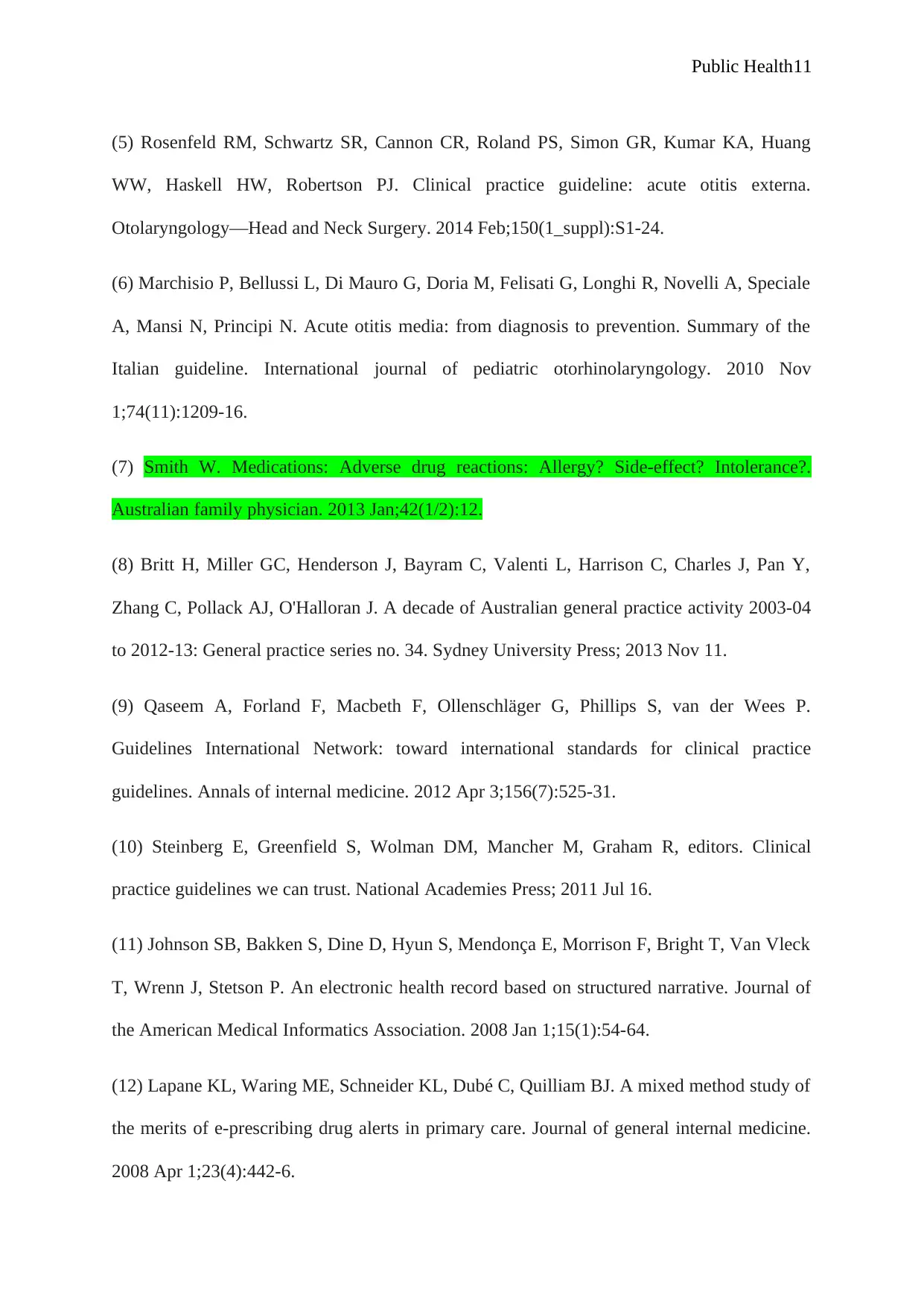
Public Health11
(5) Rosenfeld RM, Schwartz SR, Cannon CR, Roland PS, Simon GR, Kumar KA, Huang
WW, Haskell HW, Robertson PJ. Clinical practice guideline: acute otitis externa.
Otolaryngology—Head and Neck Surgery. 2014 Feb;150(1_suppl):S1-24.
(6) Marchisio P, Bellussi L, Di Mauro G, Doria M, Felisati G, Longhi R, Novelli A, Speciale
A, Mansi N, Principi N. Acute otitis media: from diagnosis to prevention. Summary of the
Italian guideline. International journal of pediatric otorhinolaryngology. 2010 Nov
1;74(11):1209-16.
(7) Smith W. Medications: Adverse drug reactions: Allergy? Side-effect? Intolerance?.
Australian family physician. 2013 Jan;42(1/2):12.
(8) Britt H, Miller GC, Henderson J, Bayram C, Valenti L, Harrison C, Charles J, Pan Y,
Zhang C, Pollack AJ, O'Halloran J. A decade of Australian general practice activity 2003-04
to 2012-13: General practice series no. 34. Sydney University Press; 2013 Nov 11.
(9) Qaseem A, Forland F, Macbeth F, Ollenschläger G, Phillips S, van der Wees P.
Guidelines International Network: toward international standards for clinical practice
guidelines. Annals of internal medicine. 2012 Apr 3;156(7):525-31.
(10) Steinberg E, Greenfield S, Wolman DM, Mancher M, Graham R, editors. Clinical
practice guidelines we can trust. National Academies Press; 2011 Jul 16.
(11) Johnson SB, Bakken S, Dine D, Hyun S, Mendonça E, Morrison F, Bright T, Van Vleck
T, Wrenn J, Stetson P. An electronic health record based on structured narrative. Journal of
the American Medical Informatics Association. 2008 Jan 1;15(1):54-64.
(12) Lapane KL, Waring ME, Schneider KL, Dubé C, Quilliam BJ. A mixed method study of
the merits of e-prescribing drug alerts in primary care. Journal of general internal medicine.
2008 Apr 1;23(4):442-6.
(5) Rosenfeld RM, Schwartz SR, Cannon CR, Roland PS, Simon GR, Kumar KA, Huang
WW, Haskell HW, Robertson PJ. Clinical practice guideline: acute otitis externa.
Otolaryngology—Head and Neck Surgery. 2014 Feb;150(1_suppl):S1-24.
(6) Marchisio P, Bellussi L, Di Mauro G, Doria M, Felisati G, Longhi R, Novelli A, Speciale
A, Mansi N, Principi N. Acute otitis media: from diagnosis to prevention. Summary of the
Italian guideline. International journal of pediatric otorhinolaryngology. 2010 Nov
1;74(11):1209-16.
(7) Smith W. Medications: Adverse drug reactions: Allergy? Side-effect? Intolerance?.
Australian family physician. 2013 Jan;42(1/2):12.
(8) Britt H, Miller GC, Henderson J, Bayram C, Valenti L, Harrison C, Charles J, Pan Y,
Zhang C, Pollack AJ, O'Halloran J. A decade of Australian general practice activity 2003-04
to 2012-13: General practice series no. 34. Sydney University Press; 2013 Nov 11.
(9) Qaseem A, Forland F, Macbeth F, Ollenschläger G, Phillips S, van der Wees P.
Guidelines International Network: toward international standards for clinical practice
guidelines. Annals of internal medicine. 2012 Apr 3;156(7):525-31.
(10) Steinberg E, Greenfield S, Wolman DM, Mancher M, Graham R, editors. Clinical
practice guidelines we can trust. National Academies Press; 2011 Jul 16.
(11) Johnson SB, Bakken S, Dine D, Hyun S, Mendonça E, Morrison F, Bright T, Van Vleck
T, Wrenn J, Stetson P. An electronic health record based on structured narrative. Journal of
the American Medical Informatics Association. 2008 Jan 1;15(1):54-64.
(12) Lapane KL, Waring ME, Schneider KL, Dubé C, Quilliam BJ. A mixed method study of
the merits of e-prescribing drug alerts in primary care. Journal of general internal medicine.
2008 Apr 1;23(4):442-6.
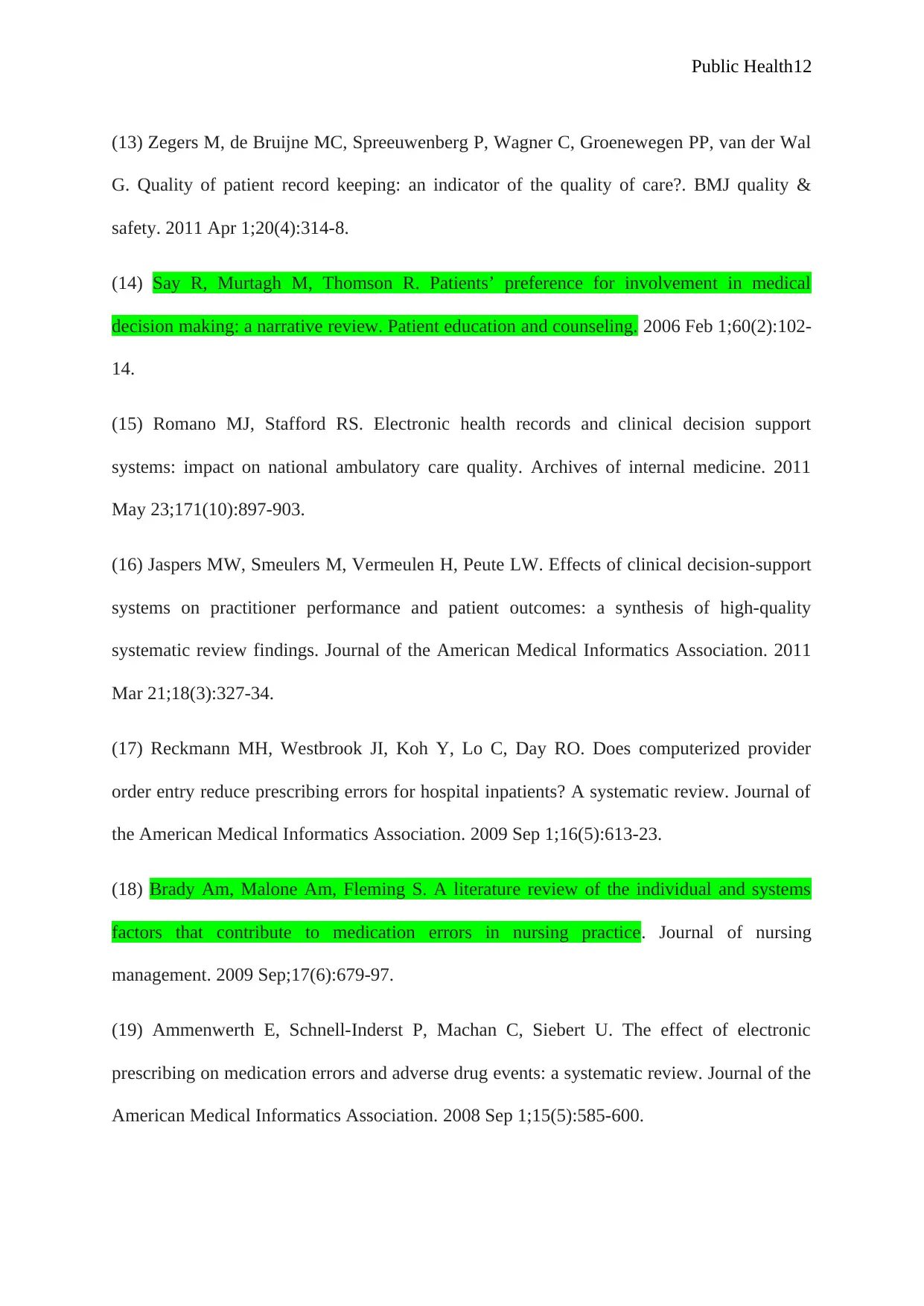
Public Health12
(13) Zegers M, de Bruijne MC, Spreeuwenberg P, Wagner C, Groenewegen PP, van der Wal
G. Quality of patient record keeping: an indicator of the quality of care?. BMJ quality &
safety. 2011 Apr 1;20(4):314-8.
(14) Say R, Murtagh M, Thomson R. Patients’ preference for involvement in medical
decision making: a narrative review. Patient education and counseling. 2006 Feb 1;60(2):102-
14.
(15) Romano MJ, Stafford RS. Electronic health records and clinical decision support
systems: impact on national ambulatory care quality. Archives of internal medicine. 2011
May 23;171(10):897-903.
(16) Jaspers MW, Smeulers M, Vermeulen H, Peute LW. Effects of clinical decision-support
systems on practitioner performance and patient outcomes: a synthesis of high-quality
systematic review findings. Journal of the American Medical Informatics Association. 2011
Mar 21;18(3):327-34.
(17) Reckmann MH, Westbrook JI, Koh Y, Lo C, Day RO. Does computerized provider
order entry reduce prescribing errors for hospital inpatients? A systematic review. Journal of
the American Medical Informatics Association. 2009 Sep 1;16(5):613-23.
(18) Brady Am, Malone Am, Fleming S. A literature review of the individual and systems
factors that contribute to medication errors in nursing practice. Journal of nursing
management. 2009 Sep;17(6):679-97.
(19) Ammenwerth E, Schnell-Inderst P, Machan C, Siebert U. The effect of electronic
prescribing on medication errors and adverse drug events: a systematic review. Journal of the
American Medical Informatics Association. 2008 Sep 1;15(5):585-600.
(13) Zegers M, de Bruijne MC, Spreeuwenberg P, Wagner C, Groenewegen PP, van der Wal
G. Quality of patient record keeping: an indicator of the quality of care?. BMJ quality &
safety. 2011 Apr 1;20(4):314-8.
(14) Say R, Murtagh M, Thomson R. Patients’ preference for involvement in medical
decision making: a narrative review. Patient education and counseling. 2006 Feb 1;60(2):102-
14.
(15) Romano MJ, Stafford RS. Electronic health records and clinical decision support
systems: impact on national ambulatory care quality. Archives of internal medicine. 2011
May 23;171(10):897-903.
(16) Jaspers MW, Smeulers M, Vermeulen H, Peute LW. Effects of clinical decision-support
systems on practitioner performance and patient outcomes: a synthesis of high-quality
systematic review findings. Journal of the American Medical Informatics Association. 2011
Mar 21;18(3):327-34.
(17) Reckmann MH, Westbrook JI, Koh Y, Lo C, Day RO. Does computerized provider
order entry reduce prescribing errors for hospital inpatients? A systematic review. Journal of
the American Medical Informatics Association. 2009 Sep 1;16(5):613-23.
(18) Brady Am, Malone Am, Fleming S. A literature review of the individual and systems
factors that contribute to medication errors in nursing practice. Journal of nursing
management. 2009 Sep;17(6):679-97.
(19) Ammenwerth E, Schnell-Inderst P, Machan C, Siebert U. The effect of electronic
prescribing on medication errors and adverse drug events: a systematic review. Journal of the
American Medical Informatics Association. 2008 Sep 1;15(5):585-600.
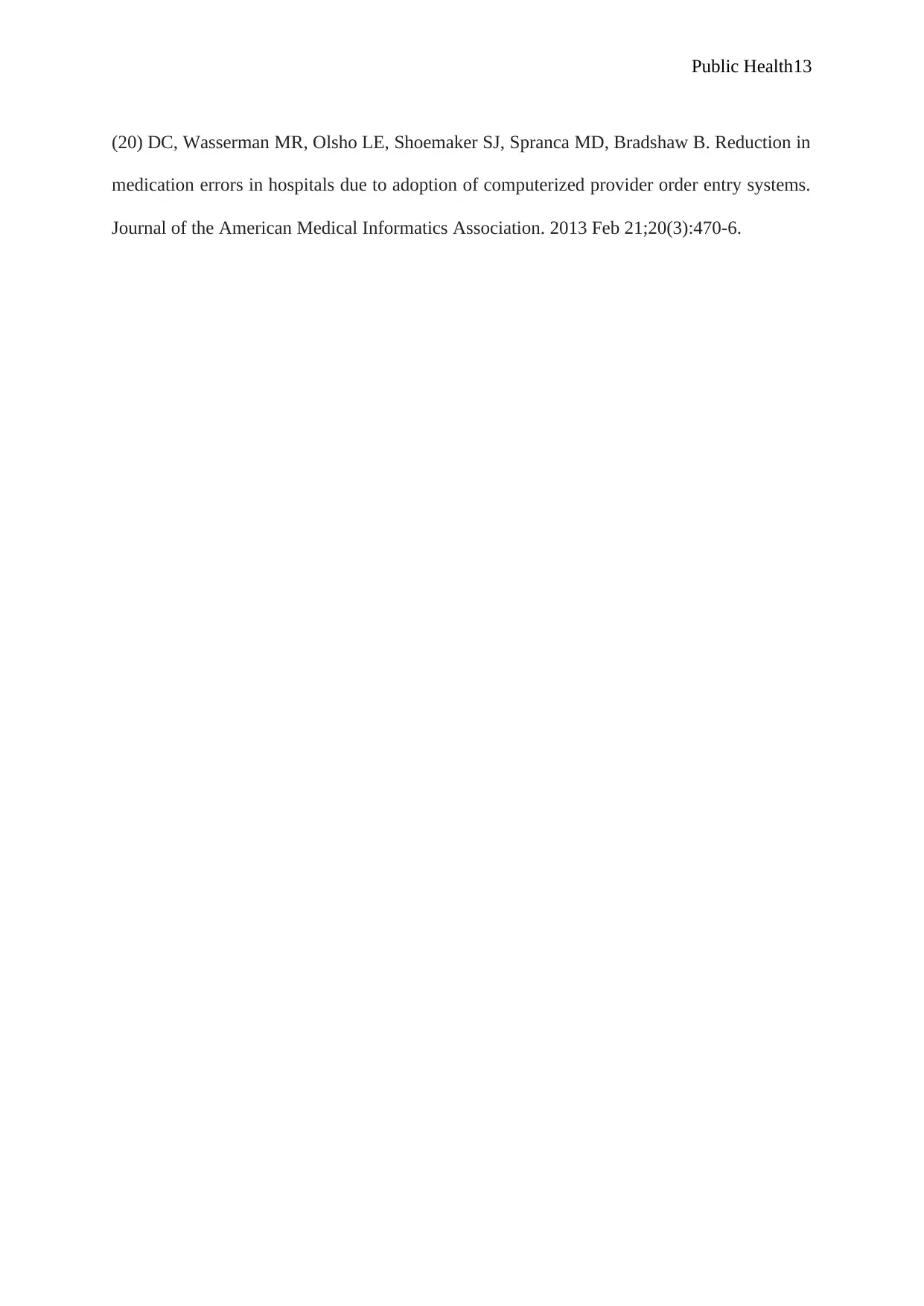
Public Health13
(20) DC, Wasserman MR, Olsho LE, Shoemaker SJ, Spranca MD, Bradshaw B. Reduction in
medication errors in hospitals due to adoption of computerized provider order entry systems.
Journal of the American Medical Informatics Association. 2013 Feb 21;20(3):470-6.
(20) DC, Wasserman MR, Olsho LE, Shoemaker SJ, Spranca MD, Bradshaw B. Reduction in
medication errors in hospitals due to adoption of computerized provider order entry systems.
Journal of the American Medical Informatics Association. 2013 Feb 21;20(3):470-6.
1 out of 13
Related Documents
Your All-in-One AI-Powered Toolkit for Academic Success.
+13062052269
info@desklib.com
Available 24*7 on WhatsApp / Email
![[object Object]](/_next/static/media/star-bottom.7253800d.svg)
Unlock your academic potential
© 2024 | Zucol Services PVT LTD | All rights reserved.





